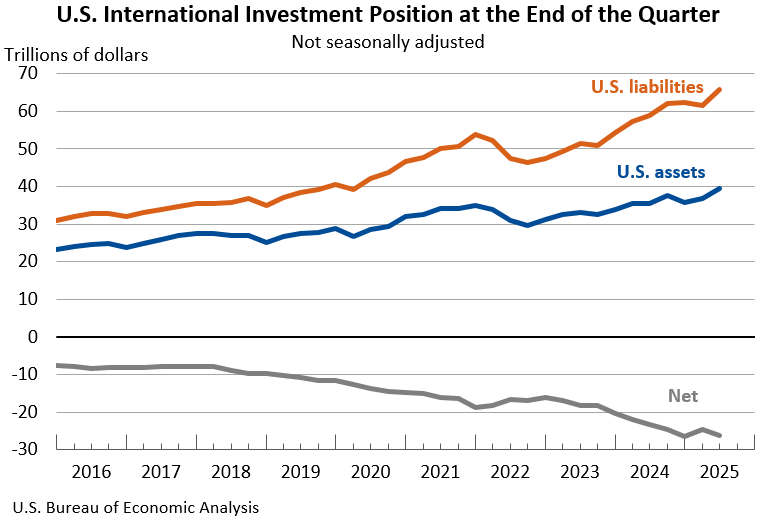Notice
Due to a lapse in appropriations, this website is not being updated.
Bureau of Economic Analysis
U.S. International Investment Position, 2nd Quarter 2025
The U.S. net international investment position, the difference between U.S. residents’ foreign financial assets and liabilities, was -$26.14 trillion at the end of the second quarter of 2025, according to statistics released today by the U.S. Bureau of Economic Analysis. Assets totaled $39.56 trillion, and liabilities were $65.71 trillion. At the end of the first quarter, the net investment position was -$24.65 trillion (revised).
Principal Federal Economic Indicators
Noteworthy
The Latest
Personal Income and Outlays, June 2020 and Annual Update
Personal income decreased 1.1 percent while consumer spending increased 5.6 percent in June, according to estimates released today by the Bureau of Economic Analysis.
Gross Domestic Product, Second Quarter 2020 (Advance Estimate) and Annual Update
Real gross domestic product (GDP) decreased at an annual rate of 32.9 percent in the second quarter of 2020, according to the “advance” estimate released by the Bureau of Economic Analysis. In the first quarter of 2020, real GDP decreased 5.0 percent. For more information, see the Technical Note.
Gross Domestic Product, 2nd Quarter 2020 (Advance Estimate) and Annual Update
Real gross domestic product (GDP) decreased at an annual rate of 32.9 percent in the second quarter of 2020, according to the “advance” estimate released by the Bureau of Economic Analysis. In the first quarter of 2020, real GDP decreased 5.0 percent.
Direct Investment by Country and Industry, 2019
The U.S. direct investment abroad position, or cumulative level of investment, increased $158.6 billion to $5.96 trillion at the end of 2019 from $5.80 trillion at the end of 2018, according to statistics released by the Bureau of Economic Analysis (BEA). The increase reflected a $95.7 billion increase in the position in Europe, primarily in the United Kingdom and the Netherlands. By industry, manufacturing affiliates accounted for most of…
Direct Investment by Country and Industry, 2019
The U.S. direct investment abroad position, or cumulative level of investment, increased $158.6 billion to $5.96 trillion at the end of 2019 from $5.80 trillion at the end of 2018, according to statistics released by the Bureau of Economic Analysis (BEA). The increase reflected a $95.7 billion increase in the position in Europe, primarily in the United Kingdom and the Netherlands. By industry, manufacturing affiliates accounted for most of the…
Annual Update of GDP Statistics Coming July 30
It’s time for BEA’s annual update of gross domestic product and related statistics. That means when we publish second quarter GDP numbers July 30, we’ll also update GDP estimates for the first quarter of 2020 and the previous five years.
Gross Domestic Product by State, 1st Quarter 2020
Real gross domestic product (GDP) decreased in all 50 states and the District of Columbia in the first quarter of 2020. The percent change in real GDP in the first quarter ranged from –1.3 percent in Nebraska to –8.2 percent in New York and Nevada.
Gross Domestic Product by State, 1st Quarter 2020
Real gross domestic product (GDP) decreased in all 50 states and the District of Columbia in the first quarter of 2020. The percent change in real GDP in the first quarter ranged from –1.3 percent in Nebraska to –8.2 percent in New York and Nevada.
Gross Domestic Product by Industry: First Quarter 2020
Accommodation and food services; finance and insurance; and health care and social assistance industries were the leading contributors to the 5.0 percent (annual rate) decrease in gross domestic product (GDP) in the first quarter of 2020.
Gross Domestic Product by Industry, 1st Quarter 2020
Accommodation and food services; finance and insurance; and health care and social assistance industries were the leading contributors to the 5.0 percent (annual rate) decrease in gross domestic product (GDP) in the first quarter of 2020.




